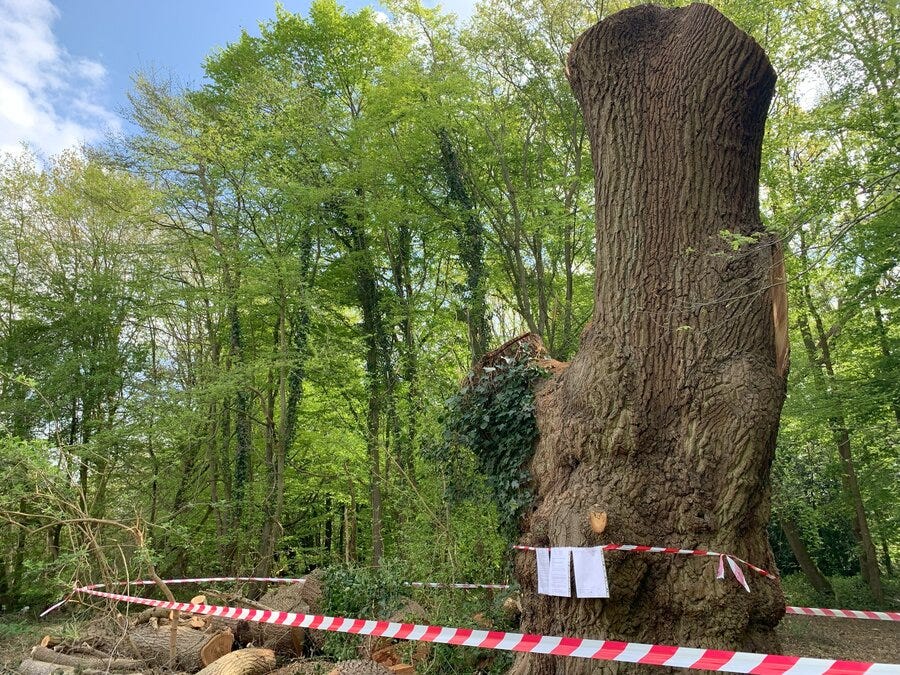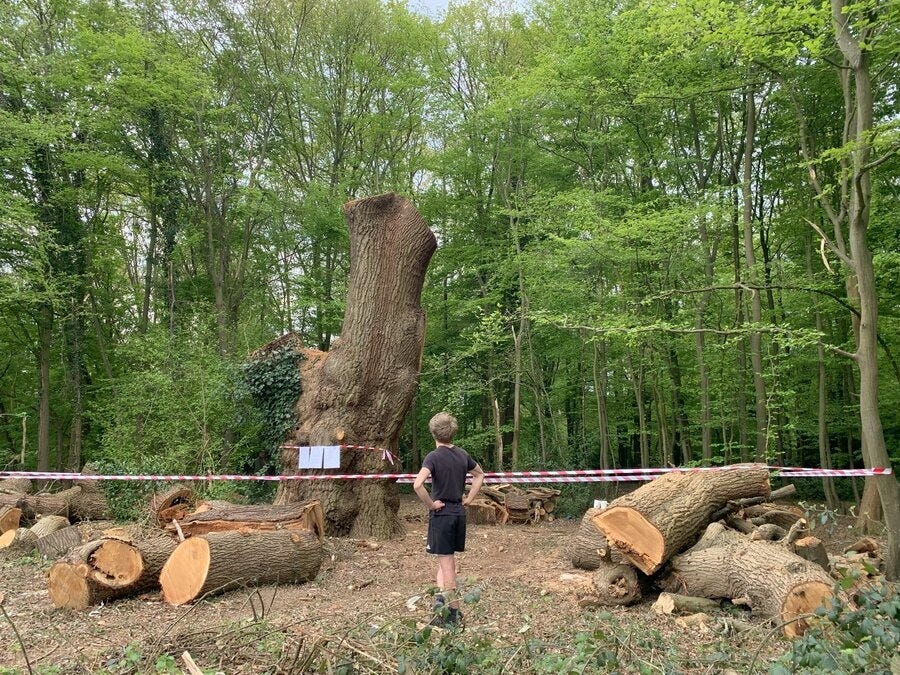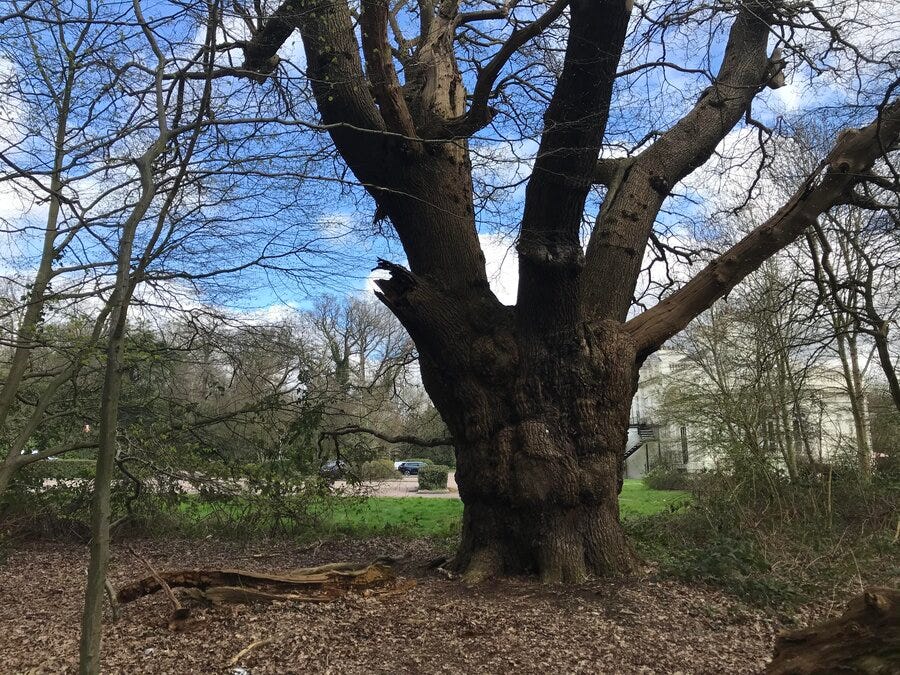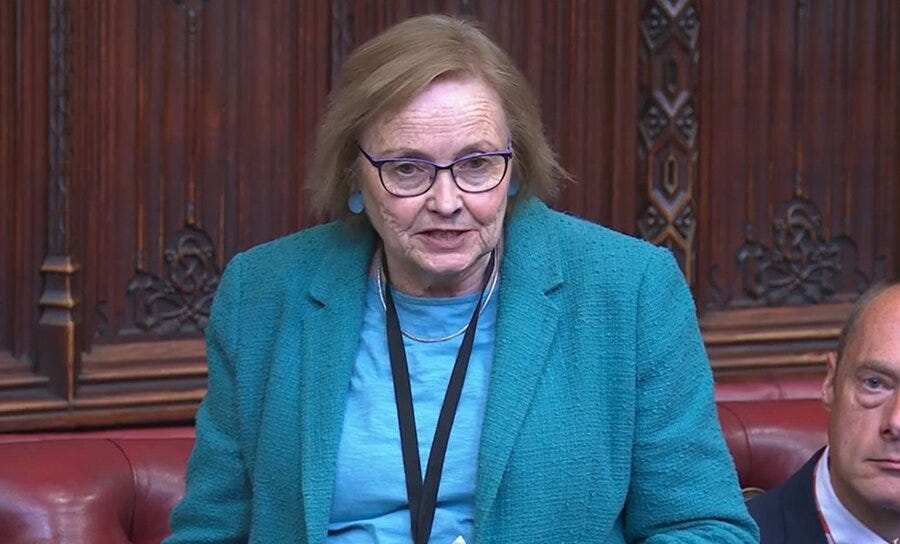The felling of the ancient Whitewebbs Oak in Enfield, London, triggered sadness and anger within the local community and far beyond. Like the Sycamore Gap tree, the public response demonstrated how much people care about trees, revealing the deep connections and personal memories that many of us have with specific trees. The case in Enfield once again highlighted the need for strengthened protections of these national treasures. It made newspaper headlines, was covered by numerous broadcasters and was even discussed in the House of Lords (see end of article).
In a strange twist of timing, on the Monday the news of the felling broke, we published a report calling for improved legal protections for our most important trees – those that provide exceptionally high social, cultural and environmental value. The report presents the findings of research commissioned by Defra and delivered in 2024 by The Tree Council and Forest Research.
This involved extensive engagement with a range of passionate experts, representing organisations like the Woodland Trust, Ancient Tree Forum, Natural England, Forestry Commission, Arboricultural Association, Wildlife and Countryside Link, People’s Trust for Endangered Species, Church of England, Trees for Cities, local authorities and many more.
For us as a research team, it was an amazing experience to bring together such a wealth of knowledge and insights, working collaboratively to review the current state of protections, and to identify actions that could make a real difference. The research emphasised the range of threats to these trees – from illegal felling to vandalism, inappropriate management and soil compaction. While it can be a complex picture, there are clear steps that can be taken, and many organisations in the sector are ready and waiting to play their crucial part in this.

Together we developed recommendations for government, including to work with key stakeholders to develop and implement a national action plan, strengthen legal protection and enforcement and provide financial assistance to help the owners of important trees to meet management costs.
The report recommends:
Engaging key stakeholders to better protect important trees, within 12 months
Developing an ‘action plan’ for important trees
Improving legal protections
Developing a public and private funding framework to support owners and managers
Enhancing data on current and future important trees
Appointing a “Special Representative” for important trees at political level
Leading positive engagement and exploring international knowledge exchange
Improving skills and capacity for management and protection of important trees
When we wrote the report, little did we know that it would receive so much attention!
It is always sad to see the loss of a tree and incredibly frustrating when nothing seems to change. How many more losses can we stand? This time, though, there is a clear set of actions that could be taken, as set out in our report, and we hope to see meaningful change in the near future.
Jess Allan is The Tree Council’s Science & Action Research Manager
House of Lords debate
A House of Lords debate initiated by an oral question from Baroness Tyler of Enfield saw the Government confirm it is currently considering the recommendations in The Tree Council and Forest Research report. Speaking on behalf of the Government, Defra Parliamentary Under Secretary, Baroness Hayman of Ullock, said: “What the Government is actually doing at the moment, is we are looking at the recommendations that are in a report from The Tree Council and Forest Research.
“This is regarding measures that are needed to improve the protections for ancient, veteran and culturally important trees.”
To read further, please visit www.treecouncil.org.uk/government-considering-tree-council-recommendations-following-enfield-oak-felling/
MORE: Sycamore Gap Tree: What it tells us about the connection between humans and trees
Find out more about The Tree Council at treecouncil.org.uk. Sign up to our monthly newsletter The Leaflet, and follow our social accounts: Instagram, TikTok, Facebook, LinkedIN, X/Twitter, YouTube.









Thank you for this and an update in due course would be very welcome. I have wondered for a long time how the thousands of abandoned but valuable ancient pollards can be managed safely and economically without destroying them by neglectful collapse or, at the other extreme, ‘Tobying’. Toby Carvery’s advice notes would indeed be interesting to compare with the Council’s survey - assuming that the main risk was thought to be collapsing trunk or falling boughs. I hope that you can get hold of these documents. The treatment of this tree is extreme and has highlighted the risk to thousands of similar relics nationwide - indeed who knows how many such fabulous trees are lost annually through ignorance or aesthetic choices as well as bad luck after apparently sound treatment to prevent collapse? The public outcry is justified here, especially when considering Toby Carvery’s dissembled assertion that the tree was dead when, even from images, that is clearly not true. On a PR note though, let’s keep to facts: the tree has been reported as felled to a stump when the actual treatment looks to be more of an excessive, obnoxious and life-threatening pollarding (that may incidentally lead to the tree’s death and further H&S risks). The much loved Sycamore has also been mentioned and it is interesting that, whilst clearly hundreds of years older, irreplaceable and ecologically far more valuable, the setting of the Whitewebbs oak has not lent itself to Instagram and so the reaction has been relatively contained.
Finally, councils may be the wrong ‘home’ for ancient trees because of the difficulty of justifying budget when competing with other local authority responsibilities and the cost of listing / surveying / advice / enforcement. Perhaps a heritage-specific authority might be considered as in the case for the care of specific buildings.